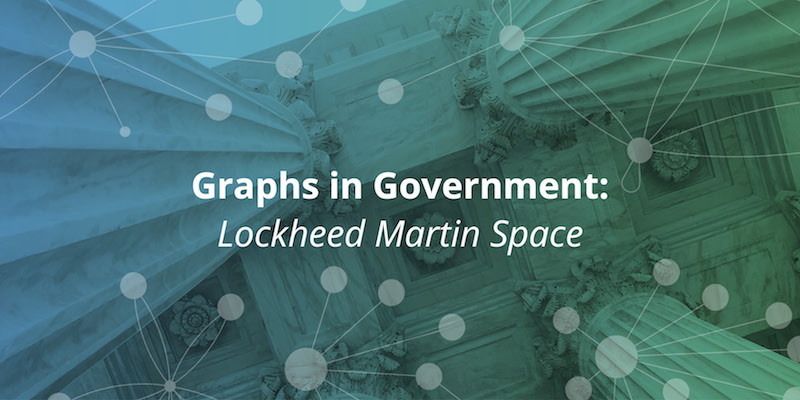Graphs in Government: Lockheed Martin Space

Federal Account Manager, Neo4j
4 min read

The use cases for a graph database in government are endless.
Graphs are versatile and dynamic. They are the key to solving the challenges you face in fulfilling your mission.
Using real-world government use cases, this blog series explains how graphs solve a broad range of complex problems that can’t be solved in any other way.
Last week we focused on a case study at MITRE, a U.S. federally funded, not-for-profit company that used Neo4j to develop CyGraph, a tool for cyberwarfare analytics, visualization and knowledge management.
This week we will look at a case study at Lockheed Martin Space (LMS). LMS is connecting all of its data silos by storing the relationships between the data and those systems in the graph database. Users will be able to submit queries to an application, which will traverse the graph database, yielding immediate answers versus weeks of research.
Product 360: Design and Supply Chain Traceability
Some products are so complex and expansive they are better described as a community of parts. In cases like these, the product is only as good as the sum of its parts, and the parts are only as good as the processes, suppliers and engineering designs they are based on.
The challenge, as LMS found, is that without visibility into the entire product ecosystem – think of it as Product 360 – there’s no way to easily gauge the downstream impact of a single variance. LMS faces a huge challenge in analyzing data from numerous systems, from engineering to ERP to procurement.
LMS wanted to integrate all of its processes and data across the entire life cycle of its highly complex products. To do so, it had to determine how to connect data across disparate data storage systems. As the LMS team sketched out the problem, the diagram with circles and lines looked like a graph.
“We went searching for graph databases, and we found Neo4j,” said Ann Grubbs, Chief Data Engineer at Lockheed Martin Space.
LMS is connecting all of its data silos by storing the relationships between the data and those systems in the graph database. Users will be able to submit queries to an application, which will traverse the graph database. Neo4j guides the application to the appropriate legacy system to drill down. The data remains in the current system, with relationships stored in Neo4j.
In the past, answering a question across systems could take weeks. Interfaces between a few key systems were built, but those interfaces were expensive and not scalable for an organization with thousands of datasets.
By connecting all their data, they get immediate answers to critical questions.
“We have tons of telemetry data coming in and artificial intelligence analyzing it,” said Grubbs. “If we see a problem emerging in a particular area, we need to know everything there is to know about that immediately,” she explained. “Who can we call? What happened in test? What did the engineering look like? We need a quick picture of everything in order to respond to that. We can’t wait two weeks to find out why a part is failing.”
The graph database enables LMSS to perform an impact analysis to determine the downstream result of an issue or change anywhere in the product life cycle. For example, if there’s a delay in engineering, how will that impact the overall schedule for the product launch?
The graph database also drives efficiencies for troubleshooting.
“In the past we’ve had someone manually identify the root cause of a failure,” Grubbs explained. “They’d identify all the things that could have influenced that part and caused it to fail. Is it engineering? Procurement? Supplier? Is it a vendor issue or a manufacturing defect? The idea is to let the graph do those traversals and find variance in the process and report it back instantaneously versus a human taking weeks to do it manually.”
Similarly, Lockheed Martin identifies potential process improvements.
“We use computer-aided design (CAD) systems, and there’s a complexity rating to CAD models,” said Grubbs. “Using Neo4j, we figure out if it’s really worth spending the time and money to get to the next rating. Will making a design more complex improve quality or not?”
But this is just the tip of the iceberg.
“We have far more data than humans alone could ever understand or manage,” said Grubbs. “With Neo4j, we’ve been able to put it in a perspective that makes sense to anyone all the way up to the CEO. There’s a lot of interest from the business. They have all kinds of business cases lined up, ready to go.”
Conclusion
As this blog series shows, Neo4j enables government agencies and organizations to do many functions, such as perform deep complex queries and reduce infrastructure costs.
Graph databases are as versatile as the government agencies that use them. In the coming week, we’ll conclude this series with a look at how NASA uses Neo4j to navigate its many data silos.
Witness how leading government agencies are using Neo4j to overcome their toughest challenges with this white paper, Graphs in Government: Fullfilling Your Mission with Neo4j. Click below to get your free copy.








